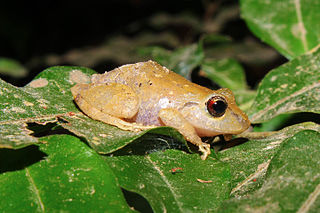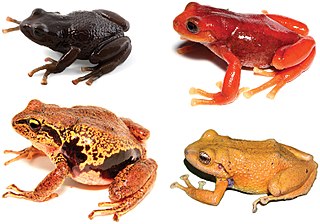
Phrynopus is a genus of frogs of the family Strabomantidae. Their common name is Andes frogs. They are endemic to Peru and inhabit the upper humid montane forest and supra-treeline grassland in the Cordillera Oriental, with one record from the Peruvian Cordillera Occidental.
Craugastor phasma is a species of frog in the family Craugastoridae. It is endemic to southeastern Costa Rica and only known from its type locality in the Las Tablas protected area in the Puntarenas Province, near the Panamanian border. Only a single individual—the holotype collected in 1992—has ever been observed. It is unusual in its ghost-like, gray-white coloration, and it was initially thought that the specimen was an albino form of some other species. However, the specimen is also morphologically distinct, although some uncertainty regarding the validity of this species remains.
Phantasmarana jordanensis is a species of frog in the family Hylodidae. It is endemic to southeastern Brazil and only known from its type locality, Campos do Jordão in the São Paulo state. Its natural habitat is forest at 1,700 m (5,600 ft) asl.
Niceforonia aderca is a species of frog in the family Strabomantidae. It is endemic to Colombia and only known from its type locality, Betulia, Santander, on the western flank of the Cordillera Oriental. It is only known from the holotype collected in 2001.
Pristimantis appendiculatus, the Pinocchio rainfrog, is a species of frog in the family Strabomantidae. It is found on the Pacific slopes of the Andes in Ecuador and extreme southern Colombia.
Eleutherodactylus counouspeus, also known as Counou robber frog and yellow cave frog, is a species of frog in the family Eleutherodactylidae. It is endemic to the Massif de la Hotte, southwestern Haiti. The specific name counouspeus refers to its type locality, Counou Bois Cave, with speus being Greek for "cave". Hedges and colleagues suggested in 2008 that it should be placed in its own monotypic subgenus, Schwartzius, reflecting its distinctiveness and honoring Albert Schwartz for "his contributions to the herpetology of the West Indies."
Niceforonia dolops is a species of frog in the family Strabomantidae. It is found in the Andes of southern Colombia and northern Ecuador. Specifically, it is known from the Cordillera Oriental and Colombian Massif in Caquetá and Putumayo Departments, Colombia, and Napo Province, Ecuador. Common name Putumayo robber frog has been coined for it.
Hypodactylus latens is a species of frog in the family Strabomantidae. It is endemic to the Cordillera Central of Colombia, and is known from the Antioquia, Caldas, Quindío, and Tolima Departments. Its natural habitats are sub-páramos and páramos at elevations of 2,690–3,350 m (8,830–10,990 ft) above sea level. It occurs on fallen leaves and grass roots. It is a rare species, although its cryptic habits might contribute to this impression. It is threatened by habitat loss (deforestation).
Niceforonia mantipus, the mantipus robber frog, is a species of frog in the family Strabomantidae. It is endemic to Colombia and found on the Cordillera Occidental and Cordillera Central, 800–2,400 m (2,600–7,900 ft) asl. Its natural habitats are cloud forests and secondary forests. It lives in leaf-litter and on ground. It is threatened by habitat loss.
Pristimantis polemistes is a species of frogs in the family Strabomantidae. It is endemic to Colombia and only known from the vicinity of its type locality in Urrao, Antioquia Department, on the western flank of the Cordillera Occidental. The specific name polemistes is Greek for "warrior" and refers to the insurgents that operated in the area of the type locality.

Pristimantis ridens, also known as the pygmy rain frog and the Rio San Juan robber frog, is a species of frog in the family Strabomantidae. It is found in western Colombia, and then through Panama and Costa Rica to Nicaragua and eastern Honduras.
Euparkerella robusta is a species of frog in the family Strabomantidae. It is endemic to the state of Espírito Santo in southeastern Brazil. It has been recorded from the municipality of Mimoso do Sul and the neighboring Atílio Vivacqua. Common name Izecksohn's Guanabara frog has been proposed for it.
Phantasmarana lutzae is a species of frog in the family Hylodidae. It is endemic to Brazil and only known from its type locality in the Itatiaia National Park, Rio de Janeiro state. It is named in honor of Bertha Lutz, a Brazilian zoologist and feminist.

Niceforonia adenobrachia is a species of frog in the family Strabomantidae. It is endemic to the Cordillera Central, Colombia, in the Caldas and Tolima Departments.
Niceforonia nana is a species of frog in the family Strabomantidae. It is endemic to the Cordillera Oriental, Colombia, and found at 3,000–3,850 m (9,840–12,630 ft) asl.
Pseudopaludicola ceratophyes is a species of frog in the family Leptodactylidae. Common name Leticia swamp frog has been coined for it, after its type locality, Leticia in Amazonas, Colombia. It is found in extreme southernmost Colombia, northeastern Peru, and adjacent western Brazil.

Craugastoridae, commonly known as fleshbelly frogs, is a family of New World direct-developing frogs. As delineated here, following the Amphibian Species of the World, it contains 129 species. They are found from the southern United States southwards to Central and South America.

Ranitomeya amazonica is a poison dart frog in the genus Ranitomeya. It was first described by Rainer Schulte in 1999 as Dendrobates amazonicus when he separated it from Dendrobates ventrimaculatus, primarily on the basis of call characteristics. The validity of the species has been debated, but further studies, also including genetic data, support its validity.

Niceforonia is a genus of frogs in the family Strabomantidae found in northern South America. The name refers to Nicéforo María, Colombian herpetologist.

Noblella is a genus of frogs in the family Strabomantidae. They are found on the eastern slopes of the Andes and in the Amazon Basin in Colombia, Ecuador, Peru, Bolivia, and western Brazil. The name refers to Gladwyn K. Noble, who described the first species.






